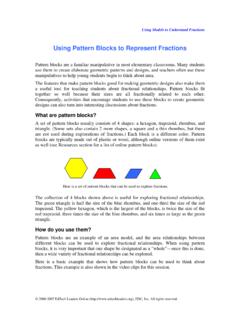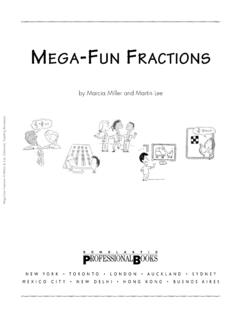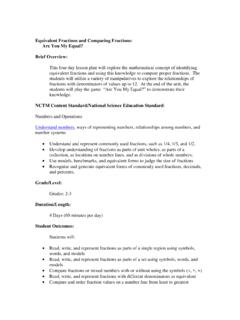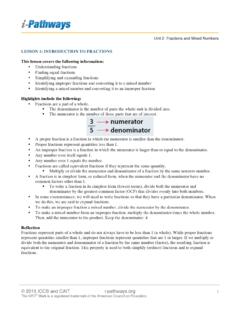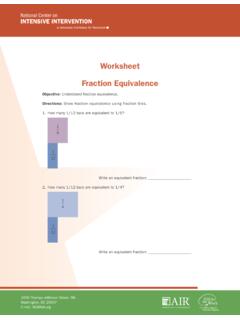Transcription of Mathematics Instructional Plan Grade 4 Fraction-Decimal ...
1 Mathematics Instructional Plan Grade 4 Fraction-Decimal Relationships with Grids Strand: Number and Number Sense Topic: identifying and representing fraction and decimal equivalents using grids Primary SOL: The student will, d) given a model, write the decimal and fraction equivalents.* * On the state assessment, items measuring this objective are assessed without the use of a calculator. Related SOL: Materials Fraction-Decimal Relationships Discovery activity sheet (attached) Fraction-Decimal Equivalence Recording Sheet (attached) Fraction-Decimal Equivalence Concentration Cards (attached) Class-display-sized 10-by-10 grid for teacher demonstration Coffee stirrers or flat straws (ones that do not roll) Base-10 materials (flats) What s my Number?
2 Decimal game board (attached) Fraction/Decimal Combo cards (Set A and B) attached Vocabulary compare, decimal, decimal equivalent, decimal point, denominator, digit, equivalent, fifth, fourth, fraction equivalent, half, hundredth, leading zero, numerator, order, place value, tenth, value, whole Student/Teacher Actions: What should students be doing? What should teachers be doing? 1. Group students in pairs, and have them explore different ways they might be able to represent fractions , using base-10 materials. Give each pair some coffee stirrers, the flat from the base-10 materials, and the Fraction-Decimal Relationships Discovery activity sheet. Allow students only five minutes to explore what fractions they can find and the decimal equivalent for the fraction.
3 Have several volunteers share out a Fraction-Decimal relationship they found. Record this on the board by modeling it on the 10-by-10 grid and then writing the numerals to represent the fraction and the decimal. Remind students about using the leading zero in decimals less than 1. 2. Distribute the Fraction-Decimal Equivalence Recording Sheet. Allow students to keep the base-10 flats and stirrers for use in this activity if they need to use them. Then, ask each student to use a pencil to shade the first grid on the recording sheet to show fractions that are halves, fourths, fifths, or tenths and then find the decimal equivalent. Observe students as they figure out the first grid , then facilitate a discussion among several students to discuss what they shaded in on their grid and what relationship they found.
4 Use a demonstration tool to show students work or enter it on the class 10-by-10 grid . Students should be guided to using precise vocabulary, such as one-fourth is equivalent to twenty-five hundredths, which is written as Ask, Is there more than Mathematics Instructional Plan Grade 4 Virginia Department of Education 2018 (Revised March 2019) 2 one way to model 14 or with the grid ? Model this on the demonstration tool or on the class 10-by-10 grid . Have students explain how they arrived at their results. Ask, How did you figure that out? a. Ask, How many small squares are in the grid ? (100) How many of the small squares are shaded in? (50) How would you write this in fraction form?
5 ( ) Review with students that the second place after the decimal is called the hundredths place. How would you write that in fraction form? Call on a student who has shaded in one-half of the grid . Use this example to help students see that 12 written as a decimal is because 50 out of the 100 small squares are shaded. b. Review the grid as columns and rows and ask, How many columns? (10) How many rows? (10) Shade in five columns on the class 10-by-10 grid and ask, What fraction is shaded? (12 ). What decimal is shaded if five of the 10 columns are shaded? ( ) Ask students to think about why 12 can be written as or as and how they would pronounce each decimal number.
6 Ask for several volunteers to share. Use the students words to highlight the equivalences, 12 = = Also, review that the first place after the decimal point is called the tenths place and the second place is the hundredths. 3. Ask students to complete the Fraction Decimal Recording Sheet, recording the fraction relationships using different fractions than those that have been discussed so far. Tell students to use what they learned while working on the first grid to shade in the fraction and then writing the equivalent decimal for the second grid . Circulate around the room and note students that are confused or have misconceptions. Ask questions to help them work through their challenges.
7 When everyone is finished, form groups of four for students to share their work, prove their thinking, or identify their missteps if challenged by a group member. 4. The fractions with a denominator of 5 are a little more challenging, and if no one has demonstrated a relationship with fifths, then facilitate a discussion about fifths. Ask the class to shade in 15 of the 10-by-10 grid . Circulate and determine which student s grids you want to use for the class discussion. Some students will be able to reason that one row, or column, is equivalent to 110, so two rows are equivalent to 210, which is equivalent to 15. Another technique is to make five equal groups out of the 100 squares.
8 Then use the grids you identify and ask students for the fraction and decimal equivalents written as numerals (15 = = ) Have students explain how they can justify the numbers. 5. Copy and cut apart the attached Decimal Fraction Equivalence Concentration Cards for students to use in playing Concentration. Students play the game in pairs. Players place the cards face down and take turns drawing two cards at a time to see whether they are a Fraction-Decimal match. There are four cards for a full match. If a player draws matching cards, he/she keeps them. If another player chooses the other two cards that Mathematics Instructional Plan Grade 4 Virginia Department of Education 2018 (Revised March 2019) 3 would complete a full match of four cards, the player with the first two cards can choose to not draw two new cards on his/her next turn but take the two cards that make a full match instead.
9 At the end of the game, students total their scores. A full match of four cards is 5 points; a half match of two cards is 2 points. The student with the highest score wins the game. Assessment Questions o What are some similarities between using fractions and decimals as numbers? What are some differences? o If you know that 15 = , how can use that information to find the decimal equivalence for 35 ? o Describe to me everything you know about the decimal that must be equivalent to 134. o Describe the relationship between money, fractions , and decimal equivalents? o If you are asked to find the decimal equivalent for 234, what can you tell me about the decimal that will represent the mixed fraction even without knowing what 34 is equivalent to as a decimal?
10 Journal/Writing Prompts o Explain how fraction and decimal equivalents can be used in the real world and how this concept is relevant to your life. o Explain to a student who was absent for the lesson how to use the 10-by-10 grid to find fraction and decimal equivalences. o Explain why decimal equivalents for halves, fourths, fifths, and tenths can each be represented with decimals in the hundredths. Other Assessments o Have student pairs use the blank grids and work together to find decimal equivalents, given fractions and mixed numbers with denominators of 2, 4, 5, and 10. Extensions and Connections Students can play the game What s my Number as a whole group or with a partner.












